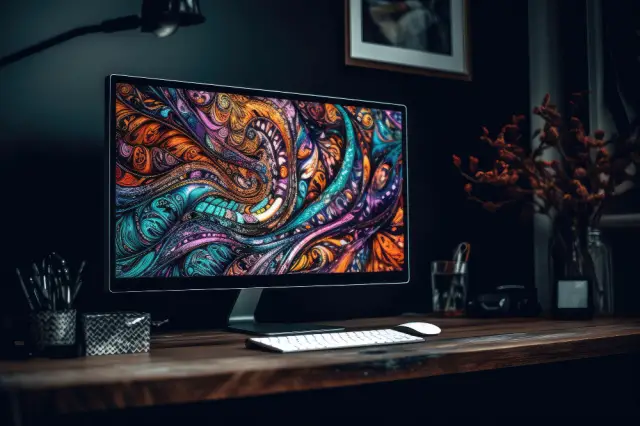Video and image display screens (televisions, computer monitors or mobile device screens) work through a combination of complex technologies that allow for high-quality results. The science behind their operation combines physics, electronics and optics.
How are images composed?
Images are made up of millions of tiny dots called pixels that determine the resolution of displays . Pixels are the smallest components of a digital image. Higher resolution means more detailed images (due to the combination of pixels with subpixels) and better quality. Each pixel can display different colors by combining red, green, and blue subpixels. Currently, a 4K monitor It offers us a magnificent visual experience due to its high resolution and advanced technology.
How do screens work?
Pixels are primarily responsible for the functioning of a screen, as all of them are made up of millions of them and the images we see are achieved due to their activation and the combination of different colors and intensities.
Display Technologies
There are several display technologies . The most common ones use LCD (liquid crystal display), LED (light-emitting diode), OLED (organic light-emitting diode) and QLED (quantum dot light-emitting diode). In LCD and LED displays, the backlight illuminates the pixels from behind. In OLED and QLED displays, each pixel emits its own light.
Types of screen
- Plasma screens: They were a true technological revolution in the 90s and early 2000s. They offered period image quality, with good contrast levels and wide viewing angles, but they were soon replaced by more advanced technologies such as LCD, LED and OLED screens.
- LCD : LCD displays use liquid crystals that change shape when an electric current is applied to them (thereby controlling the amount of light passing through them). They require backlighting, usually provided by LEDs.
- LED: Using light-emitting diodes for backlighting, it offers greater energy efficiency and better brightness. LED monitors are brighter and more energy efficient.
- OLED : Each pixel emits its own light when an electrical current is applied, enabling deeper blacks and better contrast . No backlighting required.
- QLED : improves the brightness and color range of LED screens, using quantum dots.
How are pixels controlled?
The turning on and off of pixels is monitored by electronic control circuits that process the incoming video signals and determine how the pixels should be illuminated to form the correct image.

Soft Drink Rate
The refresh rate indicates how many times per second the screen updates the image (measured in hertz, Hz). The higher the refresh rate, the smoother the image, which is especially noticeable in videos and games.
Display Controller
It is a chip located in the device that interprets the input signals and sends instructions to the pixels about what colors to display and when to change them. The video signal comes from various sources (computers, DVD players, video game consoles, portable device screens or television broadcasts) and is converted into visible images by the display driver and control circuits .
Permanent evolution
Behind the technological advances that today's screens display, there is a long (and fascinating) history that is reflected, above all, in television sets. Although CRT (cathode ray tube) televisions have been replaced by more advanced technologies, they are still considered an engineering marvel of their time.
How does a plasma screen work?
The plasma screen is made up of thousands of tiny cells containing neon and xenon, sandwiched between two glass plates. When an electric current is applied to the cells, the gases are excited and turn into a plasma that emits ultraviolet light and interacts with a phosphor coating on the inside of each cell.
Image Formation
Each cell acts as a pixel on the screen. The combination of red, green and blue cells in different intensities allows a full-color image to be formed.
How did an old TV work?
In principle, we can say that the cathode ray tube is a large glass bulb containing a partial vacuum and a barrel at its narrowest end that emits a beam of electrons towards a phosphor-coated screen at the opposite end. This screen emits light when it is hit by the electrons that, through electric and magnetic fields, focus the spot to generate the image seen on the screen.
Scanning
This is the process by which electrons scan the screen from left to right and from top to bottom line by line at high speed. This procedure occurred about 60 times per second (60 Hz), which is enough to create a continuous image for the human eye.
Video Signal
In older color TVs, the video signal is broken down into three electron guns, one for each primary color: red, green, and blue (RGB). In black-and-white TVs, only one signal strength is used to form the image.
Deflection and Synchronization
Magnetic fields generated by the deflection coils ensured that the direction of the electron beam hit the correct part of the screen while timing circuits ensured that the scanning of the electrons was perfectly synchronized with the incoming video signal.
Sound
The sound was transmitted separately and amplified with built-in speakers.
Power Supply
CRT televisions required a considerable power supply to operate the electron gun and deflection coils. The high voltage required was generated internally.
4K Monitors
4K monitors are specifically designed for those looking for the best possible image quality, such as visual professionals and video game enthusiasts.
A 4K monitor is a type of display that offers a resolution of 3840 x 2160 pixels, which means it has four times the number of pixels of a Full HD monitor (1920 x 1080 pixels).
Highlights of 4K monitors
- Ultra-high resolution: translates to clearer, more detailed images.
- Higher pixel density, providing sharper, smoother images, especially on larger screens.
- Improved image quality : They are ideal for viewing high-definition content and tasks that require fine details.
- Compatibility: To get the most out of a 4K monitor, you'll need a graphics card that supports this resolution and, in some cases, a suitable cable (such as HDMI 2.0 or DisplayPort).
- Common uses : Gaming, video and photo editing, and productivity (it is possible to have windows and applications open simultaneously without losing clarity).
What should we take into account when purchasing a 4K monitor?
On the one hand, you have to take into account the screen size, because it influences the pixel density. On the other hand, the refresh rate, since in games a high refresh rate (such as 144Hz) provides a smoother experience. Finally, you have to take into account the hardware compatibility.
In summary
There is no doubt that screens are part of our daily lives these days, as they allow us to connect with images for different purposes such as work, study, information and entertainment . Accessing an increasingly detailed visualization is a real satisfaction.
